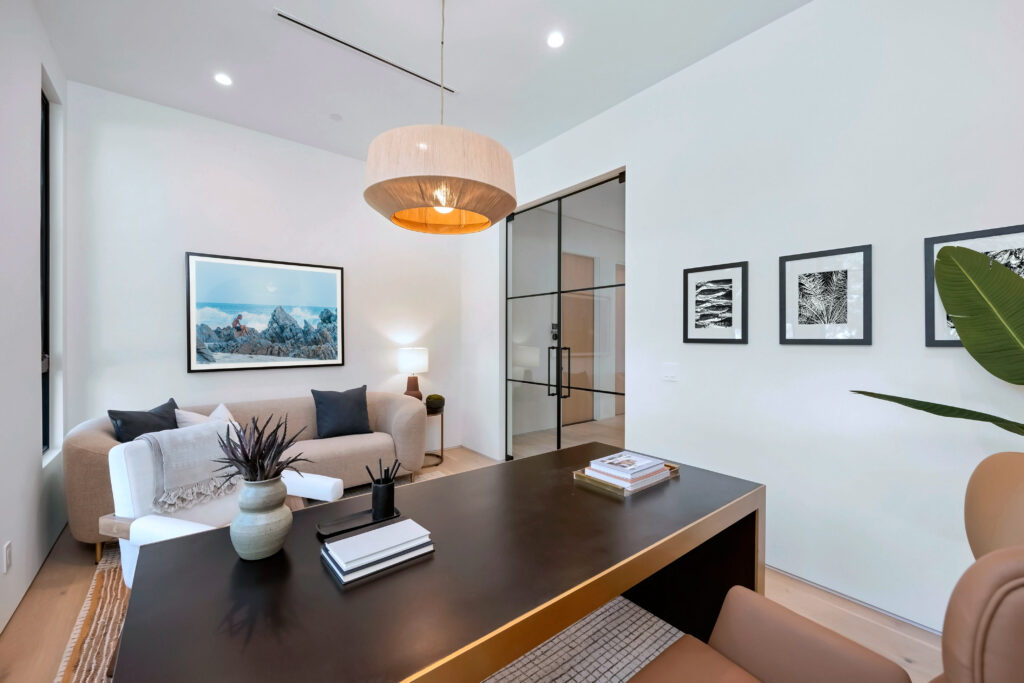- Knowledge
Digital technology is an integral part of the modern workplace.
The 21st Century office would cease to function without the software and hardware that enables companies to connect, transact and do business. From computers, laptops, whiteboards and projectors, to Wi-Fi, cloud computing and remote access platforms, the workplace as we know it is shaped by digital technology.
But the office is changing. Exciting and immersive new technologies are being introduced to the work environment, transforming the way businesses communicate and create brand awareness. Sensory and experiential, these technologies blend aesthetics and function to boost creativity, drive innovation, strengthen culture and promote wellbeing – redefining the workplace experience.

The integration of media architecture in the office
Around the world, the use of ‘media architecture’ on building exteriors is well established. The term itself refers to installations in which digital displays are incorporated into architectural structures. Anyone who has visited New York or London will be familiar with the digital façades and 3D billboards of Times Square and Picadilly Circus – prime examples of media architecture in action.
But media architecture is also becoming a feature of the modern workplace, with LED screens, themed lighting, interactive displays and sound systems being integrated into office interiors. Once the stuff of sci-fi cinema (for example, the holographic projection technology seen in Blade Runner and Star Wars), these innovations are now blurring the lines between the digital and the physical in contemporary workspace. In turn, they are creating opportunities for new forms of communication and experience, revolutionising the office environment. As we discuss in this article, projection mapping, immersive audiovisuals and hologram communications are no longer future imaginings – they are present workplace realities.
By leveraging this cutting-edge technology, companies can promote social interaction, engagement and discovery, transforming people’s relationship with their workplace. Indeed, through the use of media architecture, businesses can enhance:
- Spatial interaction: creating interactive spaces that influence how people experience and move through a workplace – for example, via wayfinding displays or immersive LED screen technology.
- Education and information: conveying facts and data via dynamic and interactive screen technology, creating experiences that educate and inform.
- Architectural qualities: highlighting and augmenting existing spatial assets, while responding to changes in the physical environment and connecting people to context.
- Mental and emotional wellbeing: creating calming ambience – e.g. via nature displays or sounds – to help reduce stress and cortisol levels; or delivering mood enhancement through seasonally adjusted visuals or energising light installations.
Technology as a canvas for content
Within the workplace, media architecture provides a canvas for digital expression. With the emergence of innovative new platforms and display capabilities, companies can transform their office spaces through dynamic and curated audiovisual material.
Whether it supports digital signage, rotating artworks, corporate branding or messaging, media architecture enables businesses to display truly bespoke content. Content which can be aligned with interior décor, design schemes, business needs and objectives, helping to create visually inspiring and culturally cohesive work environments.
Digital media technology is also flexible, meaning installations are not fixed – they can be changed to support specific occasions and events, or to fit with shifting business cycles and seasons. What’s more, tech platforms are portable, so displays can be relocated as required, enlivening different areas or anticipating future building adjustments. In this way, media architecture and technology not only provide a blank canvas, but a highly versatile framework from which to promote creative and strategic content.
The types of content to display in your workspace
So, what types of content can you use and what will maximise impact for your business?
Your content selection will depend on several factors. Firstly, different types of companies may be inclined towards different types of content. Traditional businesses and financial institutions, for example, may opt for data insights and displays (reinforcing their connection to ‘numbers’), or digital artwork depicting corporate skylines and centres of commerce. Creative companies, on the other hand, might choose something more unorthodox, reflecting their uniqueness in unusual artwork and displays. through digital artwork and displays
Secondly, the content you select could depend on your office space and real estate. Different spaces (see below) will be better suited to different kinds of media architecture and, in turn, different content typologies. You therefore need to assess your available spaces and the technology they can accommodate.
In general, content tends to fall into the following categories:
- Brand storytelling: branded video graphics, images or showreels that communicate a company’s vision, values, culture and beliefs.
- Experiential digital art: immersive, conceptual and interactive artwork that uses light, colour, sound and motion to deliver powerful emotional impact.
- Data insights: data points leveraged to create 3D renders, single images or motion graphics, illuminating key information linked to a company’s purpose or performance.
- Branded presentations: high-impact projections, graphics and artwork to support pitches to clients or presentations to employees and other stakeholders.
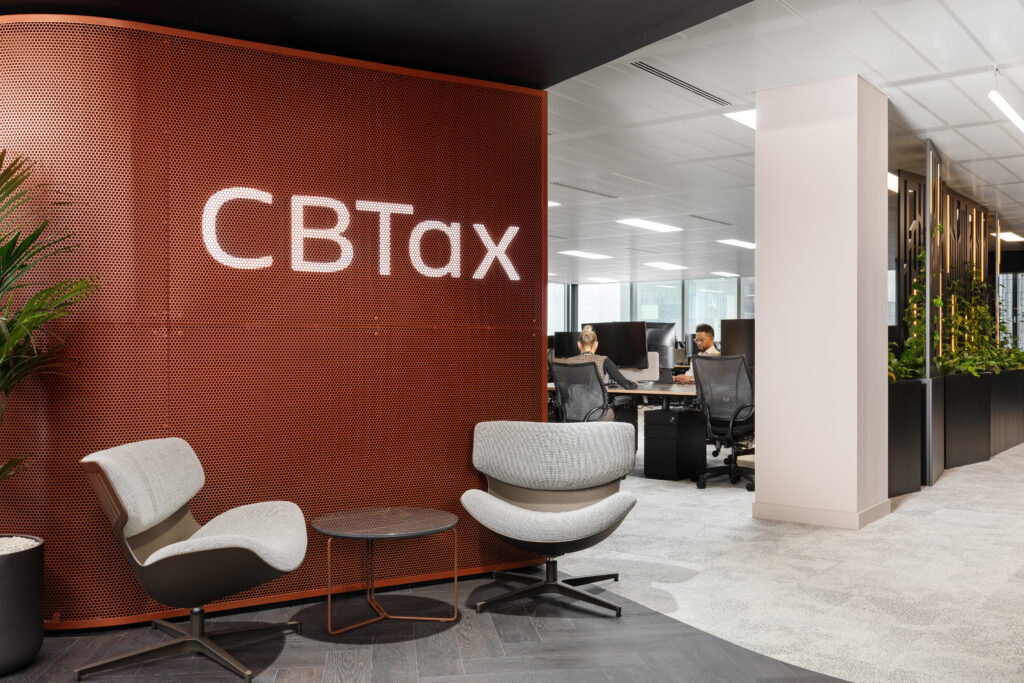
Locations for immersive technology in the office
Different work spaces offer different impact potential for digital technology and content. Reception areas, for example, can be used to create a strong impression on clients and visitors upon arrival. As they cross the corporate threshold, the reception is often the first physical point of contact with your business – a prime location (space permitting) for high-impact displays and LED screen installations. Whether you opt for branded content or conceptual artwork, this is a great opportunity to set the mood and tone for the experience you want to create.
Meeting rooms provide a platform for branded presentations. They offer a space where you can deploy cutting-edge display technology to promote corporate messaging and imagery – and in the process reinforce brand values – to a truly captive audience.
Communal areas and tea-points, meanwhile, are an opportunity to engage employees with experiential, interactive content that inspires, entertains or calms.
Board rooms and conference spaces
can be prime locations for projection mapping and branded content, enabling you to make a strong visual impact during high-level meetings with colleagues or clients.
Corridors and passageways are the perfect areas for interactive wayfinding, ensuring you engage employees and visitors even when they are in transit.
And building exteriors and façades present a highly visible platform for branded content that paints a powerful picture to passersby, communicating who you are and what you do to the outside world.
Blending function and aesthetics
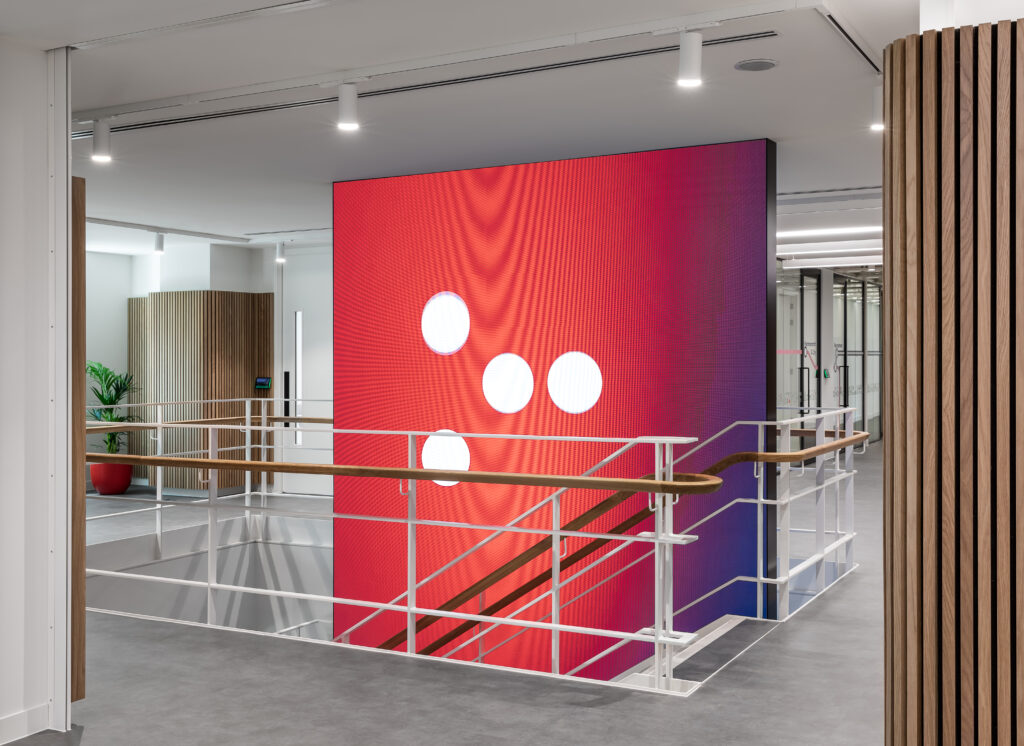
Traditionally, technology has been deployed in the work environment for functional purposes. But today, innovative workplace technology is being used to support both function and aesthetics. Brand storytelling and presentations, for instance, serve the strategic role of promoting key information about a company’s identity and performance. At the same time, the same technology deployed in these scenarios can be used for aesthetic purposes, facilitating mood enhancement and artistic expression to create emotional impact. Digital wayfinding, for instance, can provide functional signage that guides visitors to their location, while simultaneously engaging them with highly aesthetic visual displays.
In this way, modern workplace tech can be leveraged to appeal to the intellect and/or the emotions, depending on the response you want to elicit. Are you looking to reassure investors about your financial outlook? Are you looking to inspire Gen Z employees? Or do you want to impress clients?
Whatever your objective, new workplace technology can help you win the hearts and minds of your target audience.
But what are the tech options available to you?
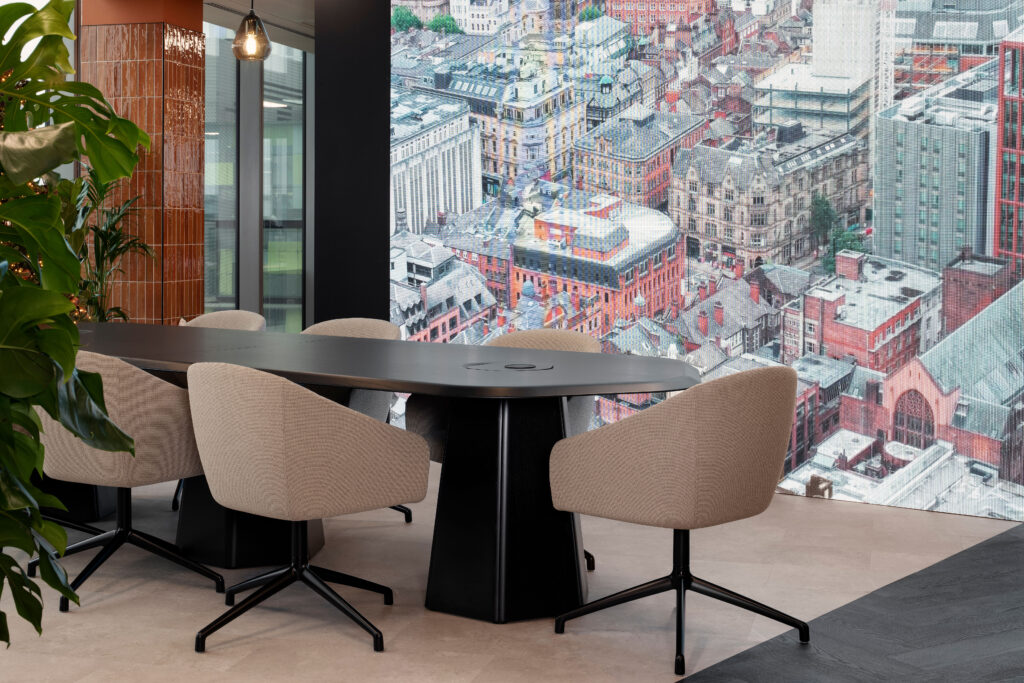
Workplace technology examples
There are a range of tech innovations currently transforming the workplace environment. Here are a few examples.
LED screen technology
LED screens are increasingly being incorporated into workplace design and structures. Whether it’s a large single screen, curved screen or entire video wall, LED screen technology provides a high-quality canvas for your digital content.
Immersive LED video walls are especially impactful, often used to create internal and external digital installations. They can be used to host mood-driven content, creating emotive sensory experiences. Video wall installations can simulate skylines, nature scenes or real-world locations, or present slow-moving visuals to reduce stress and enhance wellness.
Video walls are created by connecting multiple LED panels into a seamless screen display
that can fill an entire wall or wrap around a room or building.
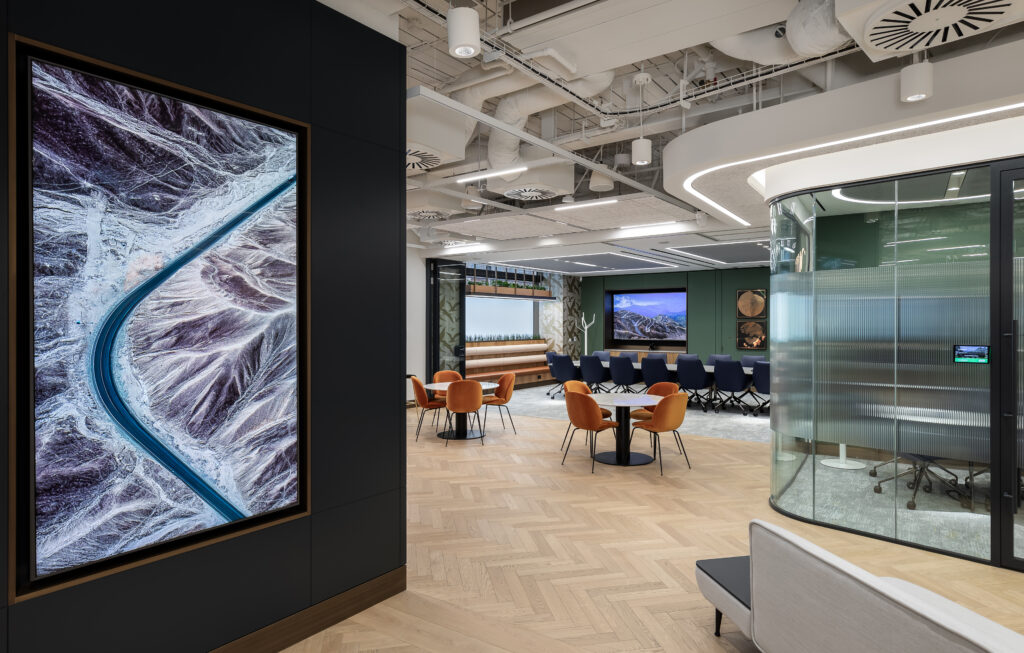
Interactive displays
Interactive, motion-response displays behave like digital mirrors, reacting to the user’s gestures and movements. High-resolution LED or LCD panels display dynamic content, which reacts in real time through the use of infrared, ultrasonic or camera-based sensors and interactive software. These displays are great for attracting passersby encouraging curiosity
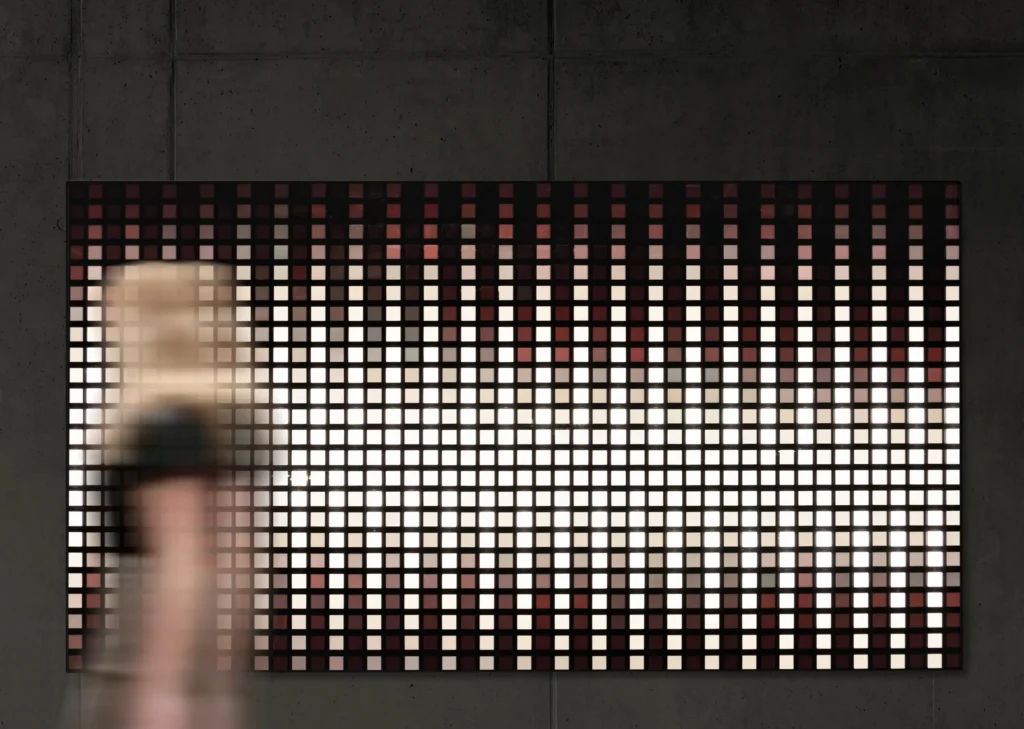
Disguised LED panelling
In an intriguing stylistic twist, LED screens can be disguised to resemble wood, stone or textured materials. The idea is that when not in use, the screens integrate seamlessly with the surrounding décor and design scheme, enhancing the overall aesthetics of the space in which they are located. At the click of a button, the screens come to life, transforming – for example – timber panelling into high-definition video or display consoles. These artful innovations make a strong visual impression on meeting participants or passersby, with the element of surprise and delight helping to reinforce key messages, brand values or campaign propositions.
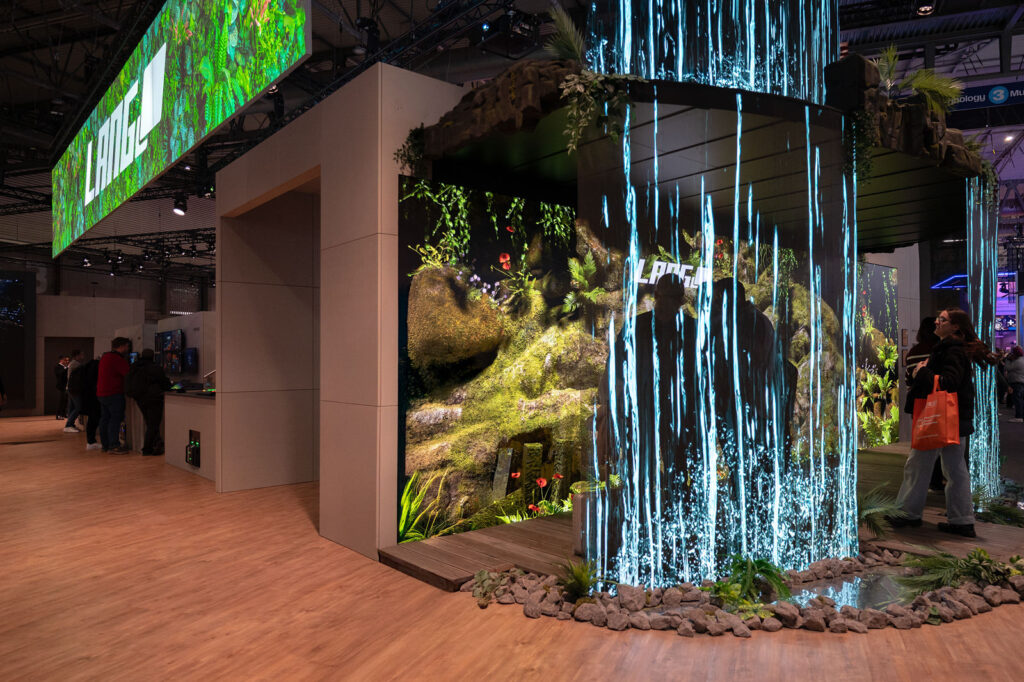
Generative AI experiences
Generative AI experiences combine real-time artificial intelligence with interactive display technology. They typically involve large-format screens with multi-touch capabilities, often including stylus support, gesture recognition and wireless connectivity. Thanks to embedded Natural Language Processing (NLP) software, the user can issue voice commands or text prompts to provide instructions to the display. These powerful tech capabilities can be deployed in workplace foyers and receptions to engage clients and visitors. They can also be used in meeting rooms to support brainstorms, pitches and presentations through interactive onscreen ‘collaboration’ and real-time data manipulation.
Projection mapping
Projection mapping is a projection technique that converts internal or external architectural structures and features (walls, floors, ceilings, pillars, panelling, roofs and façades) into display surfaces. Through state-of-the-art projection technology, this technique generates fully immersive video experiences. It is often used to support film launches or promotional events, with 3D projections of characters or products adorning the built environment. In the same way, it can be leveraged in work settings to convert corporate surfaces into dynamic, reactive canvases. It provides a platform for immersive brand storytelling and engagement, transforming pitches, meetings or workplace events into truly experiential moments. Some meeting rooms are even customised to maximise the visual impact of projection mapping

Virtual and holographic communication
Technology is of course a great enabler of workplace communication, enhancing the ability of individuals and teams to connect and interact. Increasingly, companies are equipped with tools that support hybrid work arrangements and interactions, with multiple platforms hosting virtual meeting spaces for video conferencing and remote collaboration.
But are the days of Zoom meetings numbered? Holographic communication is now gaining momentum – with tech innovations enabling hologram representations of colleagues or clients, who are located elsewhere, to be virtually ‘present’ at meetings or events. For example, offering deployable hologram pods for corporate use, with a focus on keynote addresses, cross-office collaborations and hybrid meetings. Indeed, holographic experiences could be the future of remote workplace communications.
Leveraging tech for competitive advantage

Digital workplace technology can create real value and advantage for companies, helping them stand out from their corporate peers during competitive processes. It can also deliver major gains in terms of brand awareness and engagement.
Spacial Artworks specialise in the creation of digital art content for use across diverse technology platforms, partnering with media architects to create powerful content solutions. Get in touch to see how the combination of technology and content can redefine your workplace.
